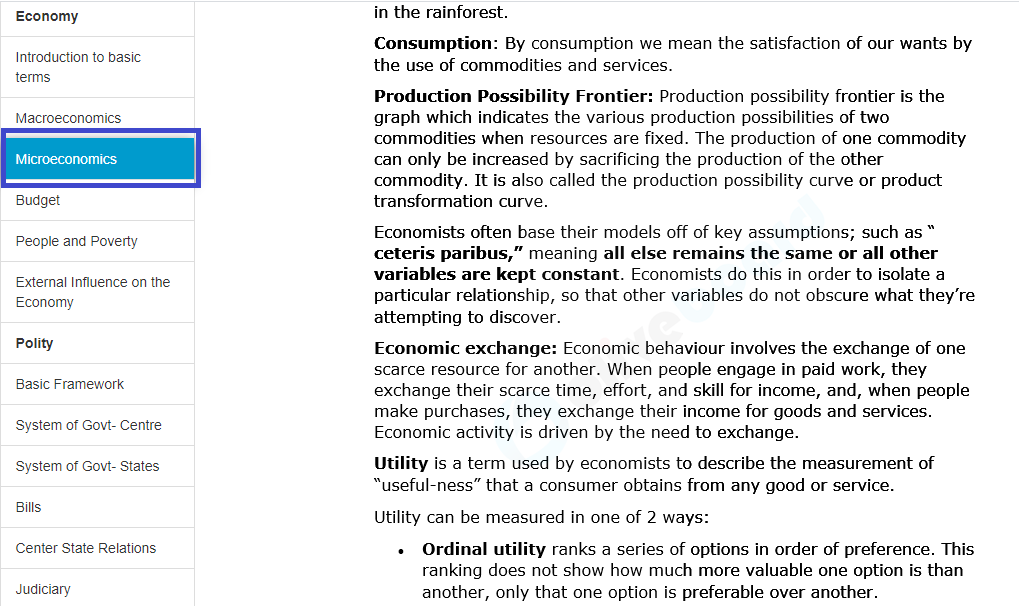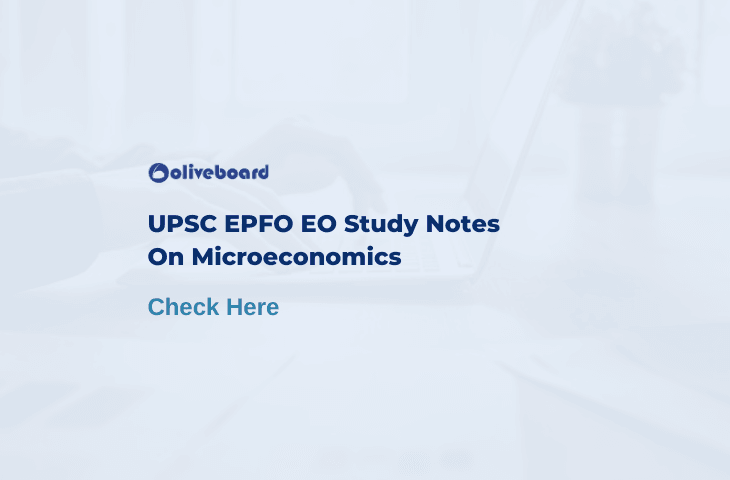UPSC EPFO EO 2020 exam is scheduled to be held in the month of October 2020 and amidst the coronavirus outbreak and lockdown, you have enough time to prepare for the examination. UPSC EPFO EO 2020 exam contains a good amount of questions from the Economics subject. To help you with the preparation we have brought a blog on the UPSC EPFO EO Microeconomics Study Notes for preparation.
1. UPSC EPFO EO Microeconomics Study Notes
1.1 What is Microeconomics?
Microeconomics can be regarded as the study of decisions that people and businesses make in terms of allocation of resources including land, labour, capital, and prices of goods and services. This field also takes into account things like taxes and regulations created by the government.
Microeconomics mainly focuses on supply and demand and other forces that determine the price levels prevalent in the economy.
1.2 MICROECONOMICS AND MACROECONOMICS
Traditionally, the subject matter of economics has been studied under two broad branches: Microeconomics and Macroeconomics. In microeconomics, we study the behavior of individual economic agents in the markets for different goods and services and try to figure out how prices and quantities of goods and services are determined through the interaction of individuals in these markets. In macroeconomics, on the other hand, we try to get an understanding of the economy as a whole by focusing our attention on aggregate measures such as total output, employment, and aggregate price level.
Here, we are interested in finding out how the levels of these aggregate measures are determined and how the levels of these aggregate measures change over time. Some of the important questions that are studied in macroeconomics are as follows: What is the level of total output in the economy? How is the total output determined? How does the total output grow over time? Are the resources of the economy (eg labour) fully employed? What are the reasons behind the unemployment of resources? Why do prices rise? Thus, instead of studying the different markets as is done in microeconomics, in macroeconomics, we try to study the behavior of aggregate or macro measures of the performance of the economy.
1.3 Examples of Microeconomics
Microeconomics and macroeconomics study the corresponding concepts at various levels. The below mentioned are representative examples of microeconomics:
- Demand: How the demand for commodities is determined by income, choices, cost prices and other circumstances such as expectations.
- Supply: This is to ascertain how manufacturers determine to enter markets, scale production, and exit markets.
- Opportunity Cost: The compromises or the trade-offs that the individuals and enterprises make to accomplish restrained resources such as money, time, land, and capital. For instance, an individual who can decide to go to an academy or begin a company that doesn’t have enough time or money to do both.
- Consumer Choice: This is to determine, how the needs, assumptions, and data influence and shape the customer choices. The notion that the customers maximize their anticipated utility of purchases; this implies that they purchase the things they assume to be most useful to them.
- Welfare Economics: Creating the influence of social programs on economic choices such as labour participation or risk-taking.
1.4 Theory of Consumer Behaviour
In this, we study the behaviour of an individual consumer. The consumer has to decide how to spend her income on different goods1. Economists call this the problem of choice. Most naturally, any consumer will want to get a combination of goods that gives her maximum satisfaction. What will be this ‘best’ combination? This depends on the likes of the consumer and what the consumer can afford to buy. The ‘likes’ of the consumer are also called ‘preferences’. And what the consumer can afford to buy, depends on the prices of the goods and the income of the consumer. Theory of Consumer Behaviour presents two different approaches that explain consumer behaviour
(i) Cardinal Utility Analysis and
(ii) Ordinal Utility Analysis.
1.4.1 UTILITY
A consumer usually decides his demand for a commodity on the basis of utility (or satisfaction) that he derives from it. What is the utility? The utility of a commodity is its want-satisfying capacity. The more the need for a commodity or the stronger the desire to have it, the greater is the utility derived from the commodity.
(i) Cardinal Utility Analysis: Cardinal utility analysis assumes that the level of utility can be expressed in numbers. For example, we can measure the utility derived from a shirt and say, this shirt gives me 50 units of utility. Before discussing further, it will be useful to have a look at two important measures of utility.
Measures of Utility
Total Utility: Total utility of a fixed quantity of a commodity (TU) is the total satisfaction derived from consuming the given amount of some commodity x. More of commodity x provides more satisfaction to the consumer. TU depends on the quantity of the commodity consumed. Therefore, TUn refers to total utility derived from consuming n units of a commodity x.
Marginal Utility: Marginal utility (MU) is the change in total utility due to consumption of one additional unit of a commodity. For example, suppose 4 bananas give us 28 units of total utility and 5 bananas give us 30 units of total utility. Clearly, consumption of the 5th banana has caused the total utility to increase by 2 units (30 units minus 28 units). Therefore, the marginal utility of the 5th banana is 2 units.
MU5 = TU5 – TU4 = 30 – 28 = 2 In general, MUn = TUn – TUn-1, where subscript n refers to the nth unit of the commodity.
Total utility and marginal utility can also be related in the following way.
TUn = MU1 + MU2 + … + MUn-1 + MUn.
This simply means that TU derived from consuming n units of bananas is the sum total of marginal utility of first banana (MU1), the marginal utility of second banana (MU2), and so on, till the marginal utility of the nth unit.
(ii) Ordinal Utility Analysis:
The Ordinal Utility approach is based on the fact that the utility of a commodity cannot be measured in absolute quantity, but however, it will be possible for a consumer to tell subjectively whether the commodity derives more or less or equal satisfaction when compared to another.
Modern economists have discarded the concept of cardinal utility and instead applied ordinal utility approach to study the behavior of the consumers. While the neo-classical economists believed that the utility can be measured and expressed in cardinal numbers, but the modern economists maintain that the utility being the psychological phenomena cannot be measured theoretically, quantitatively and even cardinally.
1.5 Types of Goods
- A Normal good
- A Luxury good
- An inferior good
- Necessity good
- Comfort good
- Complementary goods
- Substitute goods
- Giffen goods
1.6 Elasticity
Elasticity is an important concept in economics. It is used to measure how responsive demand (or supply) is in response to changes in another variable (such as price).
1.6.1 Types of Elasticity
- Price Elasticity of Supply
- Cross Elasticity of Demand
- Income Elasticity of Demand
1.6.2 Major factors which affect the Elasticity of Demand of a commodity
Nature of goods
⇓
Availability of substitutes
⇓
Number of uses of a good
⇓
Distribution of income
⇓
Level of Price/ Postponement of consumption
⇓
Number of uses
⇓
Habits
⇓
Time period
2. UPSC EPFO EO Study Notes
1. 10 Mock Tests for EPFO EO in the latest pattern with detailed solutions
2. Summary Notes for all sections (except Quant, Eng)
- Indian Freedom Struggle (Click Here For Notes)
- Indian Polity and Economy (Click Here For Notes)
- General Accounting Principles (Click Here For Notes)
- Industrial Relations and Labor Laws (Click Here For Notes)
- General Science and Knowledge of Computer Applications (Click Here For Notes)
- Social Security in India (Click Here For Notes)

3. UPSC EPFO EO Study Material | Preparation Strategy
For topic-wise EPFO EO preparation strategy and preparation tips click on the blog link given below.
This was all from us in this blog UPSC EPFO EO Microeconomics Study Notes. Hope the information provided above will help you in your exam preparation. Stay tuned for more exam related information.
All The Best For Your Exam Preparation!
- IBPS PO Vacancy 2025 Out, 5208 Vacancies Released, Latest Update
- Effective Study Strategies for the PFRDA Grade A Statistics
- Antonyms for SSC CHSL, Attempt 40 Questions Practice Set & Know Tips
- SSC CHSL Court Clerk Vs Bank Clerk – Which Job is Better? Know Here
- SSC CHSL Vs Bank Clerk Exam, Which Is Easy To Crack? Check Details
Also, Check:
